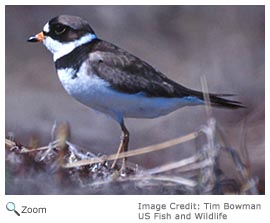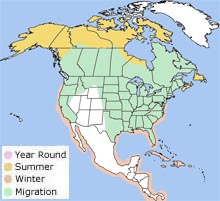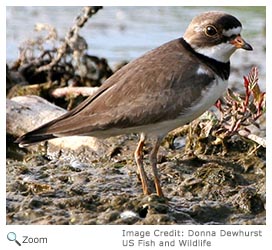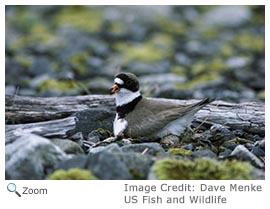Description
 The semipalmated plover is about seven inches in length. It has a brown back and white undersides. It has a white neck and throat with a black band around it and orange legs and feet. Its black bill has an orange band around it. The semipalmated plover has a black band on the top of its head, white "eyebrows" and a white patch between its eyes. The semipalmated plover is about seven inches in length. It has a brown back and white undersides. It has a white neck and throat with a black band around it and orange legs and feet. Its black bill has an orange band around it. The semipalmated plover has a black band on the top of its head, white "eyebrows" and a white patch between its eyes.
Range
 The semipalmated plover breeds from Alaska to Newfoundland and Nova Scotia. It winters along the Atlantic and Pacific coasts from California and the Carolinas south. The semipalmated plover breeds from Alaska to Newfoundland and Nova Scotia. It winters along the Atlantic and Pacific coasts from California and the Carolinas south.
|
|
Habitat
 The semipalmated plover breeds on sandy or mossy tundra. During migration and in the winter, it is found on mudflats, salt marshes, and lakeshores. The semipalmated plover breeds on sandy or mossy tundra. During migration and in the winter, it is found on mudflats, salt marshes, and lakeshores.
DietThe semipalmated plover eats insects like grasshoppers, mosquitoes, and locusts. It also eats crustaceans and mollusks.
Life Cycle
 The female lays 3-4 eggs in a depression in the ground. In sandy areas, the nest is lined with shell fragments and pebbles. On the tundra, the nest is lined with plants. Both the male and female incubate the eggs. The chicks hatch in a little under a month. They fledge in 3-4 weeks. The female lays 3-4 eggs in a depression in the ground. In sandy areas, the nest is lined with shell fragments and pebbles. On the tundra, the nest is lined with plants. Both the male and female incubate the eggs. The chicks hatch in a little under a month. They fledge in 3-4 weeks.
BehaviorThe semipalmated plover is very territorial during mating season and often flies a few feet over its territory to warn other plovers away.
|



 The semipalmated plover breeds from Alaska to Newfoundland and Nova Scotia. It winters along the Atlantic and Pacific coasts from California and the Carolinas south.
The semipalmated plover breeds from Alaska to Newfoundland and Nova Scotia. It winters along the Atlantic and Pacific coasts from California and the Carolinas south.
